
Jan Brueghelthe Elder was a Flemish painter and draughtsman. He was the son of the eminent Flemish Renaissance painter Pieter Bruegel the Elder. A close friend and frequent collaborator with Peter Paul Rubens, the two artists were the leading Flemish painters in the first three decades of the 17th century.
Aniello Falcone was an Italian Baroque painter, active in Naples and noted for his painted depictions of battle scenes. Some sources refer to him as Ancillo Falcone.

David Teniers the Younger or David Teniers II was a Flemish Baroque painter, printmaker, draughtsman, miniaturist painter, staffage painter, copyist and art curator. He was an extremely versatile artist known for his prolific output. He was an innovator in a wide range of genres such as history painting, genre painting, landscape painting, portrait and still life. He is now best remembered as the leading Flemish genre painter of his day. Teniers is particularly known for developing the peasant genre, the tavern scene, pictures of collections and scenes with alchemists and physicians.

Cornelis de Vos was a Flemish painter, draughtsman and art dealer. He was one of the leading portrait painters in Antwerp and is best known for his sensitive portraits, in particular of children and families. He was also successful in other genres including history, religious and genre painting. He was a regular collaborator with Rubens.

Gaspar de Witte was a Flemish painter who is known for his landscapes and gallery paintings.

Flemish Baroque painting was a style of painting in the Southern Netherlands during Spanish control in the 16th and 17th centuries. The period roughly begins when the Dutch Republic was split from the Habsburg Spain regions to the south with the Spanish recapturing of Antwerp in 1585 and goes until about 1700, when Spanish Habsburg authority ended with the death of King Charles II. Antwerp, home to the prominent artists Peter Paul Rubens, Anthony van Dyck, and Jacob Jordaens, was the artistic nexus, while other notable cities include Brussels and Ghent.

Tobias Verhaecht (1561–1631) was a painter from Antwerp in the Duchy of Brabant who primarily painted landscapes. His style was indebted to the mannerist world landscape developed by artists like Joachim Patinir and Pieter Bruegel the Elder. He was the first teacher of Pieter Paul Rubens.
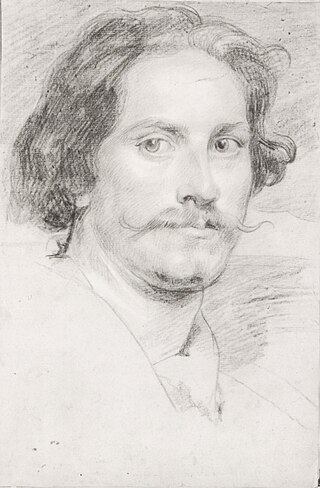
Jan Boeckhorst or Johann Bockhorst was a German-born Flemish Baroque painter and draughtsman who worked most of his career in Antwerp. He was a versatile artist who produced history paintings, genre scenes and portraits in a style influenced by the trio of leading Antwerp painters Peter Paul Rubens, Anthony van Dyck and Jacob Jordaens. Boeckhorst also worked as a designer of cartoons for tapestries.

Cornelis Schut was a Flemish painter, draughtsman, engraver and tapestry designer who specialized in religious and mythological scenes. Presumed to have trained under Rubens, he treated Counter-Reformation subjects in a High-Baroque style. After a stay in Italy, he worked mainly in Antwerp where he was one of the leading history painters in the first half of the 17th century.
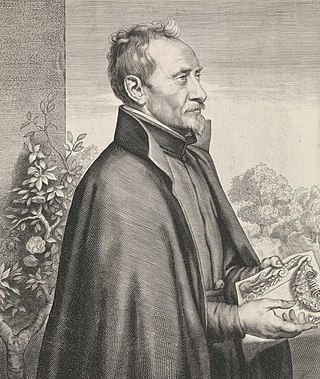
Daniël Seghers or Daniel Seghers was a Flemish Jesuit brother and painter who specialized in flower still lifes. He is particularly well known for his contributions to the genre of flower garland painting. His paintings were collected enthusiastically by aristocratic patrons and he had numerous followers and imitators.

Jan Wildens was a Flemish painter and draughtsman specializing in landscapes. His Realist landscapes show an eye for detail and have a serene character. He was a regular collaborator with Rubens and other leading Flemish Baroque painters of his generation in whose compositions he painted the landscapes.
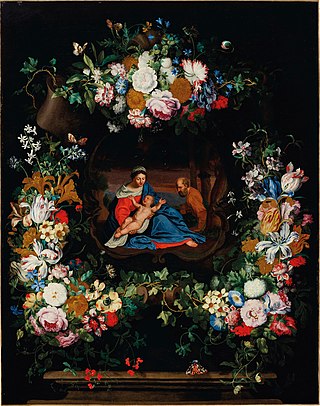
Jan Pieter Brueghel or Jan Peeter Brueghel was a Flemish painter who specialised in flower still lifes and garland paintings. A scion of the famous Brueghel family of painters, he trained in Antwerp with his father and later worked in Liège, Paris and Italy.

The Palazzo Zevallos Stigliano is a Baroque palace located on Via Toledo number 185 in the quartiere San Ferdinando of central Naples, Italy. It is also called the Palazzo Zevallos or Palazzo Colonna di Stigliano, and since 2014 serves as a museum of artworks, mainly spanning the 17th through the early 20th centuries, sponsored by the Cultural Project of the bank Intesa Sanpaolo. This museum is linked to the Museum or Gallerie di Piazza Scala in Milan and the Museum at Palazzo Leoni Montanari in Vicenza, also owned by the Bank.

The Villa Carafa of Belvedere, formerly known as Palazzo Vandeneynden, and also known as Villa Belvedere, is a monumental villa in Naples, located in the hilly Vomero district. The villa was commissioned by the powerful magnate, nobleman and art collector Ferdinando Vandeneynden, also known as Ferdinand van den Eynde, from the Carthusian architect Bonaventura Presti.

Jan van den Eynde or Vandeneynden was a prominent Netherlandish merchant, banker, art collector, and patron of the arts. He was brother to Flemish merchant, art collector and art dealer Ferdinand van den Eynde, and father of the latter's namesake Ferdinand van den Eynde, Marquess of Castelnuovo. Van den Eynde's granddaughters were Elisabeth van den Eynde, Princess of Belvedere and Baroness of Gallicchio and Missanello, and Jane (Giovanna) van den Eynde, Princess of Galatro and Sonnino.
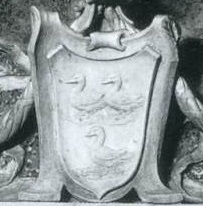
Ferdinand van den Eynde, 1st Marquess of Castelnuovo was an Italian nobleman and magnate of Flemish descent. He was the son of Jan van den Eynde, and the father of Elisabeth van den Eynde, Princess of Belvedere and Baroness of Gallicchio and Missanello and Jane (Giovanna) van den Eynde, Princess of Galatro and Sonnino. He should not be confused with his namesake and uncle Ferdinand van den Eynde.

Elisabeth van den Eynde, Princess of Belvedere and suo jure Baroness of Gallicchio and Missanello was an Italian noblewoman. She was the consort of Carlo Carafa, 3rd Prince of Belvedere, 6th Marquess of Anzi, and Lord of Trivigno, and the daughter of Ferdinand van den Eynde, 1st Marquess of Castelnuovo and Olimpia Piccolomini, of the House of Piccolomini. Her grandfather was Jan van den Eynde, a wealthy Flemish merchant, banker and art collector who purchased and renovated the Palazzo Zevallos Stigliano in 1653. Her father Ferdinand, the Marquess of Castelnuovo, built the Vandeneynden Palace of Belvedere between 1671 and 1673. While the Palazzo Zevallos in central Naples passed to her elder sister Giovanna, who married a Colonna heir, Elisabeth was given the monumental Palazzo Vandeneynden, alongside a smaller portion of the Marquess' assets, which included his art collection, one of the largest and most valuable in Naples and its surroundings. Upon her marriage to Carlo Carafa, the Vandeneynden Palace came to be known as Villa Carafa.
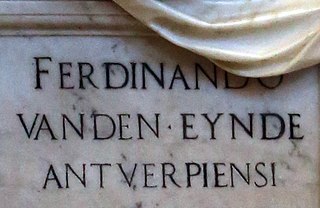
Ferdinand van den Eynde (early 17th century – 1630) was a Flemish art collector, art dealer and merchant. Ferdinand was part of the Van den Eynde family, and brother of the wealthy banker and merchant Jan van den Eynde. He should not be confused with the latter's son, Ferdinand. Ferdinand's collection included paintings by the likes of Pieter van Laer, Paul Bril, Peter Paul Rubens and Jan Miel. Ferdinand van den Eynde is also remembered for being the subject of Duquesnoy's Tomb of Ferdinand van den Eynde.
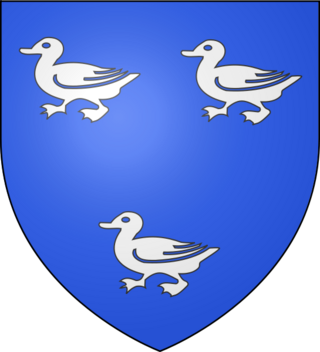
Van den Eynde is the name of an old Netherlandish noble family. One of the earliest recorded Van den Eynde to use the three-duck canting arms was Jacob van den Eynde, first Councilor and pensionary of Delft, and the highest official in the county of Holland. The Van den Eynde became especially prominent in 16th-century Delft, 17th-century Antwerp and Naples.
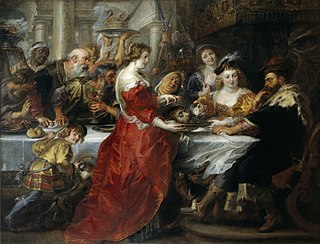
The Feast of Herod is a c.1635-1638 oil on canvas painting by Peter Paul Rubens, now in the National Galleries of Scotland, for which it was bought in 1958.



















